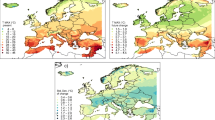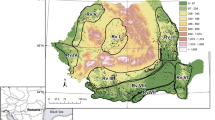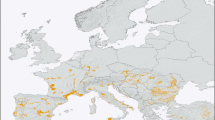Abstract
Wine production is strongly affected by weather and climate and thus highly vulnerable to climate change. In Portugal, viticulture and wine production are an important economic activity. In the present study, current bioclimatic zoning in Portugal (1950–2000) and its projected changes under future climate conditions (2041–2070) are assessed through the analysis of an aggregated, categorized bioclimatic index (CatI) at a very high spatial resolution (near 1 km). CatI incorporates the most relevant bioclimatic characteristics of a given region, thus allowing the direct comparison between different regions. Future viticultural zoning is achieved using data from 13 climate model transient experiments following the A1B emission scenario. These data are downscaled using a two-step method of spatial pattern downscaling. This downscaling approach allows characterizing mesoclimatic influences on viticulture throughout Portugal. Results for the recent past depict the current spatial variability of Portuguese viticultural regions. Under future climate conditions, the current viticultural zoning is projected to undergo significant changes, which may represent important challenges for the Portuguese winemaking sector. The changes are quite robust across the different climate models. A lower bioclimatic diversity is also projected, resulting from a more homogeneous warm and dry climate in most of the wine regions. This will lead to changes in varietal suitability and wine characteristics of each region.





Similar content being viewed by others
References
Alves F, Costa J, Costa P, Correia CM, Gonçalves BM, Soares R, Moutinho-Pereira J (2012) Influence of climate and deficit irrigation on grapevine physiology, yield and quality attributes, of the cv. Touriga Nacional at Douro Region. In: Proceeding of the IX international Terroirs congress, 25–29 June, Dijon-Reims, France
Amerine MA, Winkler AJ (1944) Composition and quality of musts and wines of California grapes. Hilgardia 15:493–675
Anderson JD, Jones GV, Tait A, Hall A, Trought MCT (2012) Analysis of viticulture region climate structure and suitability in New Zealand. Journal International des Sciences de la Vigne et du Vin 46(3):149–165
Blanco-Ward D, Queijeiro JMG, Jones GV (2007) Spatial climate variability and viticulture in the Mino River Valley of Spain. Vitis 46(2):63–70
Carbonneau A (2003) Ecophysiologie de la vigne et terroir. In: Terroir, zonazione, viticoltura. Trattato internazionale. Phytoline, pp 61–102
Chaves MM, Zarrouk O, Francisco R, Costa JM, Santos T, Regalado AP, Rodrigues ML, Lopes CM (2010) Grapevine under deficit irrigation: hints from physiological and molecular data. Ann Bot 105(5):661–676. doi:10.1093/aob/mcq030
Duchene E, Schneider C (2005) Grapevine and climatic changes: a glance at the situation in Alsace. Agron Sustain Dev 25(1):93–99. doi:10.1051/Agro:2004057
EEA (2002) CORINE land cover update, I&CLC2000 project, Technical guidelines
Ferreira MI, Silvestre J, Conceição N, Malheiro AC (2012) Crop and stress coefficients in rainfed and deficit irrigation vineyards using sap flow techniques. Irrig Sci 30(5):433–447. doi:10.1007/s00271-012-0352-2
Flexas J, Galmes J, Galle A, Gulias J, Pou A, Ribas-Carbo M, Tomas M, Medrano H (2010) Improving water use efficiency in grapevines: potential physiological targets for biotechnological improvement. Aust J Grape Wine Res 16:106–121. doi:10.1111/j.1755-0238.2009.00057.x
Fraga H, Malheiro AC, Moutinho-Pereira J, Santos JA (2012a) An overview of climate change impacts on European viticulture. Food Energy Secur 1(2):94–110. doi:10.1002/fes3.14
Fraga H, Santos JA, Malheiro AC, Moutinho-Pereira J (2012b) Climate change projections for the portuguese viticulture using a multi-model ensemble. Ciência Téc Vitiv 27(1):39–48
Fraga H, Malheiro AC, Moutinho-Pereira J, Santos JA (2013) Future scenarios for viticultural zoning in Europe: ensemble projections and uncertainties. Int J Biometeorol 1–17. doi:10.1007/s00484-012-0617-8
Hall A, Jones GV (2010) Spatial analysis of climate in winegrape-growing regions in Australia. Aust J Grape Wine Res 16(3):389–404. doi:10.1111/j.1755-0238.2010.00100.x
Harbertson JF, Keller M (2012) Rootstock effects on deficit-irrigated winegrapes in a dry climate: grape and wine composition. Am J Enol Vitic 63(1):40–48. doi:10.5344/ajev.2011.11079
Hardie WJ, Martin SR (2000) Shoot growth on de-fruited grapevines: a physiological indicator for irrigation scheduling. Aust J Grape Wine Res 6(1):52–58. doi:10.1111/j.1755-0238.2000.tb00162.x
Hay LE, Wilby RJL, Leavesley GH (2000) A comparison of delta change and downscaled GCM scenarios for three mountainous basins in the United States. J Am Water Resour Assoc 36(2):387–397. doi:10.1111/j.1752-1688.2000.tb04276.x
Haylock MR, Hofstra N, Klein Tank AMG, Klok EJ, Jones PD, New M (2008) A European daily high-resolution gridded data set of surface temperature and precipitation for 1950–2006. J Geophys Res 113(D20):D20119. doi:10.1029/2008jd010201
Hijmans RJ, Cameron SE, Parra JL, Jones PG, Jarvis A (2005) Very high resolution interpolated climate surfaces for global land areas. Int J Climatol 25(15):1965–1978. doi:10.1002/joc.1276
Huglin P (1978) Nouveau mode d’évaluation des possibilités héliothermiques d’un milieu viticole. Comptes Rendus de l’Académie d’Agriculture. Académie d’agriculture de France 64(13):1117–1126
IPCC (2001) Climate change 2001: synthesis report. In: Watson RT, The Core Team (eds) A contribution of working groups I, II, III to the third assessment report of the Intergovernmental Panel on Climate Change. Cambridge University Press, Cambridge and New York, 398 pp
IVV (2011) Vinhos e Aguardentes de Portugal, Anuário 2010/2011. Ministério da Agricultura, do Desenvolvimento Rural e das Pescas: Instituto da Vinha e do Vinho, Lisboa
Jones GV (2006) Climate and terroir: impacts of climate variability and change on wine in fine wine and terroir—the geoscience perspective. In: Macqueen RW, Meinert LD (eds) Geoscience Canada, Geological Association of Canada, St. John’s, Newfoundland, Canada, Geoscience Canada
Jones GV (2012) A climate assessment for the Douro Wine Region: an examination for the past. Present and future conditions for wine production. ADVID, Peso da Régua
Jones GV, Alves F (2012a) Impact of climate change on wine production: a global overview and regional assessment in the Douro Valley of Portugal. Int J Glob Warming 4(3/4):383–406
Jones GV, Alves F (2012b) Spatial analysis of climate in winegrape growing regions in Portugal. In: Proceedings of the 9th international Terroir congress, vol 3, pp 1–4, 25–29 June, 2012, Burgundy and Champagne, France
Jones GV, Davis RE (2000) Climate influences on grapevine phenology, grape composition, and wine production and quality for Bordeaux, France. Am J Enol Vitic 51(3):249–261
Jones GV, Goodrich GB (2008) Influence of climate variability on wine regions in the western USA and on wine quality in the Napa Valley. Clim Res 35(3):241–254. doi:10.3354/cr00708
Jones GV, White MA, Cooper OR, Storchmann K (2005) Climate change and global wine quality. Clim Change 73(3):319–343. doi:10.1007/s10584-005-4704-2
Jones GV, Duff AA, Hall A, Myers JW (2010) Spatial analysis of climate in winegrape growing regions in the Western United States. Am J Enol Vitic 61(3):313–326
Kenny GJ, Harrison PA (1992) The effects of climate variability and change on grape suitability in Europe. J Wine Res 3(3):163–183. doi:10.1080/09571269208717931
Lopes J, Eiras-Dias JE, Abreu F, Climaco P, Cunha JP, Silvestre J (2008) Thermal requirements, duration and precocity of phenological stages of grapevine cultivars of the Portuguese collection. Ciencia E Tecnica Vitivinicola 23(1):61–71
Lopes CM, Santos TP, Monteiro A, Rodrigues ML, Costa JM, Chaves MM (2011) Combining cover cropping with deficit irrigation in a Mediterranean low vigor vineyard. Sci Hortic-Amsterdam 129(4):603–612. doi:10.1016/j.scienta.2011.04.033
Lorenzo MN, Taboada JJ, Lorenzo JF, Ramos AM (2012) Influence of climate on grape production and wine quality in the Rías Baixas, north-western Spain. Reg Environ Change 1–10. doi:10.1007/s10113-012-0387-1
Magalhães N (2008) Tratado de viticultura: a videira, a vinha e o terroir. Chaves Ferreira, Lisboa
Malheiro AC, Santos JA, Fraga H, Pinto JG (2010) Climate change scenarios applied to viticultural zoning in Europe. Clim Res 43(3):163–177. doi:10.3354/cr00918
Moutinho-Pereira JM, Correia CM, Goncalves BM, Bacelar EA, Torres-Pereira JM (2004) Leaf gas exchange and water relations of grapevines grown in three different conditions. Photosynthetica 42(1):81–86
Moutinho-Pereira J, Goncalves B, Bacelar E, Cunha JB, Coutinho J, Correia CM (2009) Effects of elevated CO2 on grapevine (Vitis vinifera L.): physiological and yield attributes. Vitis 48(4):159–165
Nakićenović N, Alcamo J, Davis G, de Vries HJM, Fenhann J, Gaffin S, Gregory K, Grubler A, Jung TY, Kram T, La Rovere EL, Michaelis L, Mori S, Morita T, Papper W, Pitcher H, Price L, Riahi K, Roehrl A, Rogner H-H, Sankovski A, Schlesinger M, Shukla P, Smith S, Swart R, van Rooijen S, Victor N, Dadi Z (2000) Emissions scenarios. A special report of working group III of the Intergovernmental Panel on climate change. Cambridge University Press, Cambridge, United Kingdom and New York, NY, USA
Neumann PA, Matzarakis A (2011) Viticulture in southwest Germany under climate change conditions. Clim Res 47(3):161–169. doi:10.3354/cr01000
OIV (2012) Statistical report on world vitiviniculture. OIV, Paris, France, 32 pp
Orlandini S, Di Stefano V, Lucchesini P, Puglisi A, Bartolini G (2009) Current trends of agroclimatic indices applied to grapevine in Tuscany (Central Italy). Idojaras 113(1–2):69–78
Pieri P, Gaudillere JP (2003) Sensitivity to training system parameters and soil surface albedo of solar radiation intercepted by vine rows. Vitis 42(2):77–82
Ramirez-Villegas J, Jarvis A (2010) Downscaling global circulation model outputs: The Delta method; decision and policy analysis working paper no 1: CIAT-CGIAR
Riou C, Carbonneau A, Becker N, Caló A, Costacurta A, Castro R, Pinto PA, Carneiro LC, Lopes C, Clímaco P, Panagiotou MM, Sotez V, Beaumond HC, Burril A, Maes J, Vossen P (1994) Le determinisme climatique de la maturation du raisin: application au zonage de la teneur en sucre dans la Communauté Européenne. Office des Publications Officielles des Communautés Européennes, Luxembourg
Santos JA, Malheiro AC, Pinto JG, Jones GV (2012) Macroclimate and viticultural zoning in Europe: observed trends and atmospheric forcing. Clim Res 51(1):89–103. doi:10.3354/Cr01056
Santos JA, Grätsch SD, Karremann MK, Jones GV, Pinto JG (2013) Ensemble projections for wine production in the Douro Valley of Portugal. Clim Change 117(1–2):211–225. doi:10.1007/s10584-012-0538-x
Tonietto J, Carbonneau A (2004) A multicriteria climatic classification system for grape-growing regions worldwide. Agric For Meteorol 124(1–2):81–97. doi:10.1016/j.agrformet.2003.06.001
van der Linden P, Mitchell JFB (2009) ENSEMBLES: climate change and its impacts: summary of research and results from the ENSEMBLES project. Met Office Hadley Centre, FitzRoy Road, Exeter EX1 3 PB, UK, 166 pp
Veloso MM, Almandanim MC, Baleiras-Couto M, Pereira HS, Carneiro LC, Fevereiro P, Eiras-Dias J (2010) Microsatellite database of grapevine (Vitis vinifera L.) cultivars used for wine production in Portugal. Ciência e Técnica Vitivinicola 25(2):53–61
Webb LB, Whetton PH, Barlow EWR (2011) Observed trends in winegrape maturity in Australia. Glob Change Biol 17(8):2707–2719. doi:10.1111/j.1365-2486.2011.02434.x
Webb LB, Whetton PH, Bhend J, Darbyshire R, Briggs PR, Barlow EWR (2012) Earlier wine-grape ripening driven by climatic warming and drying and management practices. Nat Clim Change 2(4):259–264. doi:10.1038/Nclimate1417
Acknowledgments
This study was carried out under the ClimVineSafe Project: Short-term climate change mitigation strategies for Mediterranean vineyards (Fundação para a Ciência e Tecnologia—FCT, Portugal, contract PTDC/AGR-ALI/110877/2009). This work is also supported by European Union Funds (FEDER/COMPETE—Operational Competitiveness Programme) and by Portuguese national funds (FCT)—under the project FCOMP-01-0124-FEDER-022692. The authors acknowledge the ENSEMBLES project (contract number GOCE-CT-2003-505539) and the WorldClim dataset (http://www.worldclim.org). We thank Rabea Haas (University of Cologne) for discussions on an earlier version of this manuscript.
Author information
Authors and Affiliations
Corresponding author
Electronic supplementary material
Below is the link to the electronic supplementary material.
Rights and permissions
About this article
Cite this article
Fraga, H., Malheiro, A.C., Moutinho-Pereira, J. et al. Very high resolution bioclimatic zoning of Portuguese wine regions: present and future scenarios. Reg Environ Change 14, 295–306 (2014). https://doi.org/10.1007/s10113-013-0490-y
Received:
Accepted:
Published:
Issue Date:
DOI: https://doi.org/10.1007/s10113-013-0490-y




